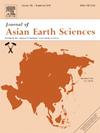Development and application of a technological system for exploration of “Datangpo-type” concealed manganese deposits in China
IF 2.7
3区 地球科学
Q2 GEOSCIENCES, MULTIDISCIPLINARY
引用次数: 0
Abstract
The “Datangpo-type” manganese deposits in northeastern Guizhou, China, represent a super-large-scale metallogenesis event characterized by the short-term discharge and deposition of deep manganese-bearing fluids under the triple control mechanism of “rift basin–transport channel–gas/liquid fluids.” Building upon a new metallogenic model for this manganese deposit type, and integrating considerations of regional geological setting and the specific conditions of exploration areas, our team has developed a relatively comprehensive technological system tailored for the exploration of Datangpo-type concealed manganese deposits. This system comprises the following components: specialized geological surveys, restoration of the prototype basin, mineralization area prediction and boundary delineation, optimization and efficiency enhancement of exploration grids, digital transformation of exploration processes, and green protection of exploration and mining environments. Through the application of this technological system, significant prospecting outcomes have been achieved. In northeastern Guizhou, four giant manganese deposits and five large- to medium-sized manganese deposits have been newly identified. The newly added manganese ore resource reserves exceed 700 million tons, establishing northeastern Guizhou as a new super-large-scale manganese ore resource hub. The technological exploration system developed for Datangpo-type concealed manganese deposits holds significant implications for prospecting other manganese deposits with similar metallogenic conditions and formation mechanisms, as well as for exploring other mineral resources with analogous origins globally.

中国“大唐坡型”隐伏锰矿勘查技术体系的开发与应用
贵州东北部“大塘坡型”锰矿床是在“裂谷盆地-输运通道-气液流体”三重控制机制下,以深部含锰流体短期排出和沉积为特征的超大型成矿事件。在建立该类型锰矿成矿新模式的基础上,结合区域地质环境和探区具体情况,研究开发了一套较为完善的大唐坡隐伏锰矿勘查技术体系。该系统包括专业化地质调查、原型盆地恢复、矿化区域预测与边界圈定、勘探网格优化与效率提升、勘探流程数字化改造、勘探采矿环境绿色保护等部分。通过该技术体系的应用,取得了显著的找矿效果。贵州东北部新发现巨型锰矿床4个,大中型锰矿床5个。新增锰矿资源储量超过7亿吨,确立了黔东北地区超大型锰矿资源新枢纽地位。大唐坡隐伏锰矿技术勘探体系的建立,对寻找具有类似成矿条件和形成机制的其他锰矿,以及全球其他类似成因的矿产资源具有重要意义。
本文章由计算机程序翻译,如有差异,请以英文原文为准。
求助全文
约1分钟内获得全文
求助全文
来源期刊

Journal of Asian Earth Sciences
地学-地球科学综合
CiteScore
5.90
自引率
10.00%
发文量
324
审稿时长
71 days
期刊介绍:
Journal of Asian Earth Sciences has an open access mirror journal Journal of Asian Earth Sciences: X, sharing the same aims and scope, editorial team, submission system and rigorous peer review.
The Journal of Asian Earth Sciences is an international interdisciplinary journal devoted to all aspects of research related to the solid Earth Sciences of Asia. The Journal publishes high quality, peer-reviewed scientific papers on the regional geology, tectonics, geochemistry and geophysics of Asia. It will be devoted primarily to research papers but short communications relating to new developments of broad interest, reviews and book reviews will also be included. Papers must have international appeal and should present work of more than local significance.
The scope includes deep processes of the Asian continent and its adjacent oceans; seismology and earthquakes; orogeny, magmatism, metamorphism and volcanism; growth, deformation and destruction of the Asian crust; crust-mantle interaction; evolution of life (early life, biostratigraphy, biogeography and mass-extinction); fluids, fluxes and reservoirs of mineral and energy resources; surface processes (weathering, erosion, transport and deposition of sediments) and resulting geomorphology; and the response of the Earth to global climate change as viewed within the Asian continent and surrounding oceans.
 求助内容:
求助内容: 应助结果提醒方式:
应助结果提醒方式:


